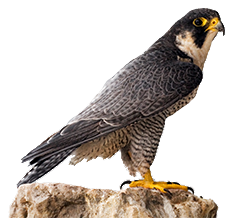Genesee Falcon Monitoring Program
An active Peregrine nesting site can be found at the half way point on our Genesee 3 stack. The Genesee Generating Station has been part of the recovery and maintenance of Peregrine Falcon populations in Alberta since the early 1990s. Capital Power has been voluntarily monitoring Peregrine Falcon nest success informally at the Genesee Generating Station since 1992. Standardized monitoring protocols were implemented in 2004 and are based on observational documentation techniques developed and in use by the Canadian Peregrine Foundation.
Since 2005, Capital Power has been livestreaming the falcons at our Genesee facility to allow viewers to learn more about the falcons and how they survive and thrive at this location and in the wild. From 2009-2016, the same female falcon returned to the nest (she was originally banded in downtown Edmonton). From 2017-2019, a new female falcon has been using the nest.
In 2009, Capital Power, in co-operation with a respected researcher engaged by Environment Canada, undertook a three-year monitoring program to track the falcons’ nesting and migration patterns. For more information, download the Falcon Diaries from 2009-2011.

About Peregrine Falcons
- The Peregrine Falcon was listed as endangered in 1978
- Post-World War 2 use of the pesticide DDT greatly impacted their populations, which was eventually linked to shell thinning and population declines in peregrines and many other birds
- Its numbers have increased steadily to 600 birds in southern Canada and 1,500 in northern Canada after DDT was banned from agricultural use in 1969
- Although currently classified as a Species at Risk in Canada, the Committee on the Status of Endangered Wildlife in Canada is now recommending to the federal government that the Peregrine be delisted as a threatened species
The Canadian Press. “Peregrine Falcon No Longer a Threatened Species after Four Decades | CBC News.” CBCnews, CBC/Radio Canada, 5 Dec. 2017.
Important Observation Periods for North America
| Activity | Observation Period |
| Return to Genesee | April (northern average = April 17) |
| Courtship | Upon return to territory |
| Nest initiation | After courtship and copulation |
| Clutch initiation | Late April to late May (northern average = May 9) |
| Incubation | Starts after the last or second last egg is laid and lasts about 33 days (range of 30-36 days) |
| Hatching | Mid-June |
| Fledging | 38-45 days after hatching (chick remains dependent on the adults for food for another 25-30 days) |
| Hunting | Post-fledging |